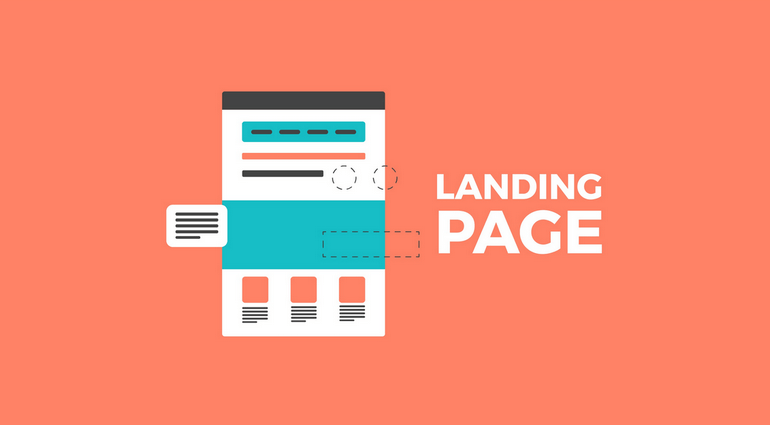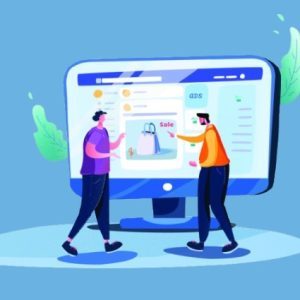Having a strong online presence is essential in today’s digital world where businesses fight to grab the attention of potential customers online. A well-designed landing page is a crucial part of an effective online marketing strategy.
We’ll discuss what a landing page is, what it’s for, what types there are, what makes them useful, and how to make one using best practices in this guide.
How Do I Create A Landing Page?

Landing Page Definition
A landing page is a web page created especially to grab a visitor’s attention and persuade them to take a particular action, like buying something, signing up for a newsletter, or completing a form.
After clicking on a link in an advertisement, search engine result, or social media post, a visitor “lands” on it.
What is a Landing Page
The main objective of a landing page is to convert visitors into leads or customers.
Landing pages concentrate on a single goal instead of a website’s homepage, which serves multiple functions and offers general information about a company.
Landing pages seek to increase conversions and encourage action by removing obstacles and presenting a clear call to action.
Components of a Successful Landing Page

Landing pages should include a few essential components to be effective:
A Catchy Headline – A landing page’s headline is crucial in grabbing the attention and igniting the interest of the visitor. It should convey the value proposition concisely and with interest.
A catchy headline makes it more likely that visitors will stay on the page and do more exploring.
An Obvious Call to Action – Every landing page needs to have a call-to-action (CTA) that is distinct and easy to see. The call to action (CTA) tells website, visitors what to do, such as “Buy Now,” “Sign Up,” or “Download.”
It should stand out visually, be simple to identify, and be strategically positioned on the page to grab readers’ attention.
Content That Is Relevant and Engaging – A landing page’s content also needs to be compelling, engaging, and relevant.
It should make it crystal clear what advantages or solutions the advertised good or service offers.
The readability of the content can be improved and made easier for visitors to consume by using bullet points, concise paragraphs, and visual components.
A Sleek and Professional Design – A landing page’s design ought to be neat, professional, and eye-catching.
The visitor’s attention is drawn to the key components by a clear layout with lots of white space.
The use of top-notch images, consistent branding, and simple navigation improves the user experience as a whole.
Landing Page Types
There are various kinds of landing pages, each with a particular function:
Landing Pages for Lead Generation – Landing pages for lead generation are designed to collect visitor data, such as name, email address, or phone number.
They frequently give something worthwhile in exchange, like a free e-book, registration for a webinar, or exclusive access to content.
These pages assist companies in growing their email lists and generating leads for upcoming marketing campaigns.
Click-Through Landing Pages – In order to persuade visitors to click through to another page, such as a product page or registration form, click-through landing pages are created.
To entice the visitor to proceed, they frequently include compelling product descriptions, client endorsements, and persuasive messaging.
Viral Landing Pages – The purpose of viral landing pages is to create buzz and promote social sharing.
They frequently contain highly shareable entertainment or thought-provoking content.
Businesses can expand their reach and raise brand awareness through viral landing pages by utilizing the power of social media.
Advantages of Landing Pages

Including landing pages in your marketing strategy has the following advantages:
Increased Conversion Rates – By directing visitors’ attention to a single action, landing pages can boost conversion rates. Landing pages direct visitors to the intended result by eliminating obstacles and outlining a clear value proposition.
Improved Lead Generation – Businesses can use lead-generation landing pages to gather important visitor data, like email addresses, for use in upcoming marketing campaigns.
Businesses can grow their customer base and nurture leads by providing something of value in exchange for contact information.
Enhanced Audience Targeting – Enhanced audience targeting allows landing pages to be customized for particular customer personas or audience segments.
Businesses can deliver targeted messaging and offers that resonate with their target audience thanks to this level of personalization, which leads to higher engagement and conversion rates.
Results That Can Be Measured – Landing pages offer insightful information about the effectiveness of campaigns. Businesses can evaluate the effectiveness of their landing pages and make data-driven optimizations by tracking metrics like conversion rates, click-through rates, and bounce rates.
Improved SEO – By optimizing landing pages for search engines, companies can raise their organic visibility and draw in more targeted traffic.
Landing pages can rank higher in search engine results and attract targeted traffic by including pertinent keywords, optimizing Meta tags, and ensuring quick page loads.
Opportunities for A/B Testing – Landing pages present a chance to run A/B tests and raise conversion rates.
Businesses can determine which variations perform better and make informed decisions to increase the effectiveness of their landing pages by testing various elements, such as headlines, CTAs, or page layouts.
Guidelines for Building Landing Pages
Take into account the following best practices to make your landing pages as effective as possible:
Set Clear Goals – Define the specific goals of your landing page. Is it to generate leads, market a service, or event? Clarifying your objectives will guide the design and messaging of the landing page.
Target Particular Audience – Recognize your target market and adjust your landing page to suit their requirements and tastes. Speak their language, deal with their issues, and provide solutions that they can relate to.
Maintain Simplicity – Keep your landing page’s design and messaging straightforward and concentrated. Keep your space free of clutter and pointless distractions that might confuse visitors and muddy the message.
SEO Optimization – To increase the visibility of your landing page in search engine results it is necessary that your landing page is properly SEO Optimized by organic SEO Experts, incorporating pertinent keywords, Meta tags, and optimized content. This will increase the likelihood of conversions and draw organic traffic.
Examine and Test – Test various landing page components, such as headlines, CTAs, forms, or images, regularly. In order to gradually increase conversion rates, analyze the findings and implement data-driven optimizations.
FAQs

Q1. How many landing pages does my website need?
The number of landing pages you need will depend on your marketing objectives and the various goods or deals you want to market. In order to ensure targeted messaging and higher conversion rates. It is advised to create distinct landing pages for each distinct campaign or audience segment.
Q2. Is it possible to use the same landing page for various marketing platforms?
While using the same landing page for various marketing channels is possible, it is typically more productive to create landing pages that are specific to each channel. You can also improve the user experience and increase conversions by matching the messaging and design to the particular marketing channel.
Q3. How can I get more people to visit my landing page?
Through a variety of channels, such as paid advertising, content marketing, social media marketing, email marketing, and search engine optimization. You can also increase traffic to your landing page. To increase the visibility of your landing page, pick the channels that best fit your target market and marketing goals.
Q4. Why should my landing page be so long?
The complexity of your offering and the amount of information required to persuade visitors to take the desired action will determine how long your landing page should be. Finding the ideal balance between giving the visitor just enough information and preventing information overload is crucial.
Q5. Should I include reviews on my landing page?
A persuasive addition to your landing page might be testimonials. They foster trust among potential customers by offering social proof. Including endorsements from pleased clients who have obtained favorable outcomes can strengthen the credibility of your offering and increase conversions.
Conclusion
A landing page is a focused web page created to grab visitors’ attention and encourage particular actions.
Businesses can also build landing pages that effectively convert visitors into leads and customers by using persuasive headlines, obvious CTAs, interesting content, and expert design.
Furthermore, businesses can maximize the advantages and accomplish their marketing goals by understanding the various types of landing pages and best practices for their creation.

Vaibhav Pandya is the Chief Operating Officer (COO) and Senior Contributing Editor at IndyLogix – Digital Marketing Agency, where he has spent 9+ years growing the organization and establishing it as a credible market leader. When it comes to anything marketing, finding good and bad nuances of evolving technology, or having a constructive and insights-driven discussion on the internet buzz, you can find him at the other side of the table with insatiable curiosity! An operational executive by day and an avid writer by night, he loves to read, write, and speak about Digital Marketing, SEO, NFT, Blockchain, AI, Web 3.0, and more. Catch up with him at @pandyavaibh






